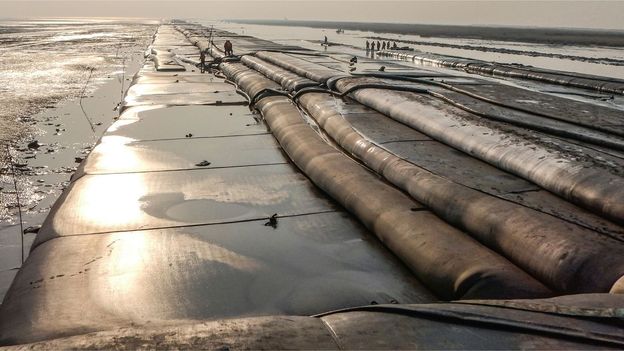
Then there are nature-based solutions for coastal defence as well – like seagrass meadows, coral reefs, mangrove forests, salt marshes and other forms of wetland. These types of habitat tend to increase in height naturally and they can also retreat further inland as sea level rises to provide constant protection. Going forward, nature-based coastal defences might be the best solution as hard concrete structures in the ocean are likely to encounter increasing problems as a result of climate change. Scientists say we’re going to see more than one metre of sea level rise within the next 80 years, causing traditional coastal defences to fail.
“Building hard concrete structures that don’t naturally adapt to increasing sea level could create an additional problem that periodically those defences will have to be built up or even replaced,” says Rogers. “Whereas nature-based solutions provide you with a solution that essentially self-repairs and keeps up with that sea level rise.”
In the UK, in extensive areas along the east coast, it’s now recognised that it’s not economically viable to continue defending the land using hard concrete structures because they only get broken up, undermined and destroyed as result of changes in the climate. Instead, there is a move towards favouring nature-based solutions, using some concrete where it’s essential.
One benefit of nature-based solutions is the huge biodiversity associated with them – in the UK these natural defences can be home to mussels, marine molluscs, fish, shellfish, salt-tolerant plants like glassworts, and seaweeds such as kelp. These areas are all also massive CO2 sinks, says Rogers. “Salt marshes have something like 40 times the CO2 absorption potential of tropical rainforests on a per area basis.”
From multiple perspectives, it appears that nature-based solutions are definitely the way forward. “Coastal engineers are going to have to change,” says Rogers. “They can’t economically afford to keep replacing concrete defences that are being undermined and destroyed by rising sea levels and increasingly extreme weather.”
Rogers believes that these engineers really need to take onboard the fact that nature can be used as a viable and long-term strategy for coastal defence and possibly even coastal reclamation.
Ultimately, of course, in an ideal world the best solution might be no reclamation. But until there’s a cost-effective alternative to concrete, or more widespread use of nature-based solutions, this material looks firmly set to stay.
--
The emissions from travel it took to report this story were 0kg CO2. The digital emissions from this story are an estimated 1.2g to 3.6g CO2 per page view. Find out more about how we calculated this figure here.
--
Join one million Future fans by liking us on Facebook, or follow us on Twitter or Instagram.
If you liked this story, sign up for the weekly bbc.com features newsletter, called “The Essential List”. A handpicked selection of stories from BBC Future, Culture, Worklife, and Travel, delivered to your inbox every Friday.
"world" - Google News
August 12, 2020 at 06:17AM
https://ift.tt/2XU8UE9
The world's growing concrete coasts - BBC News
"world" - Google News
https://ift.tt/3d80zBJ
https://ift.tt/2WkdbyX
Bagikan Berita Ini














0 Response to "The world's growing concrete coasts - BBC News"
Post a Comment